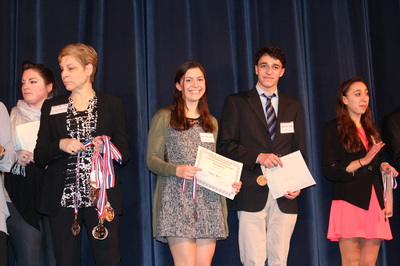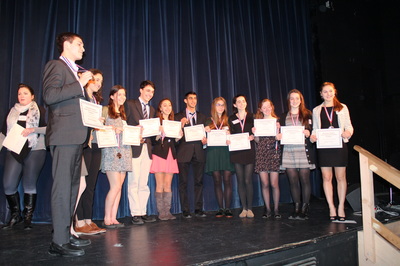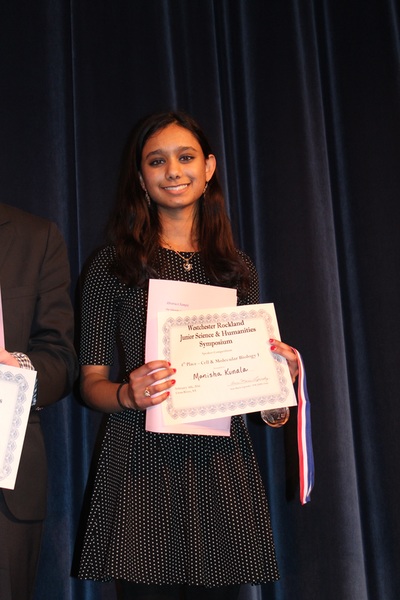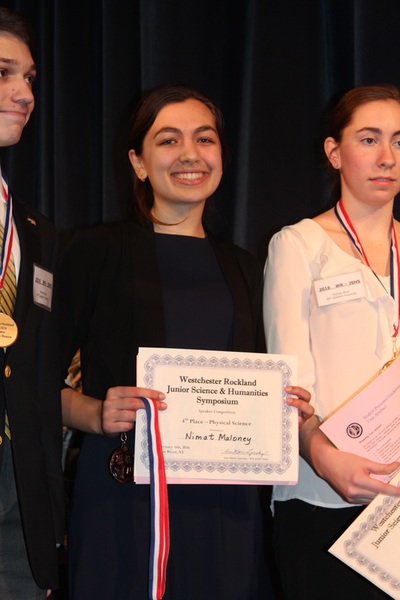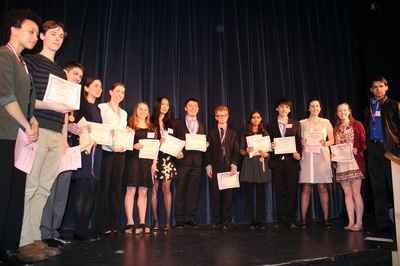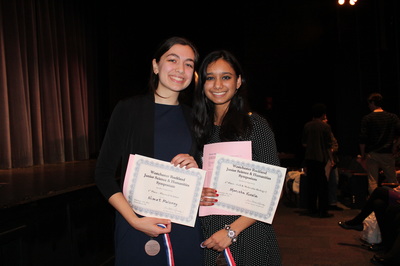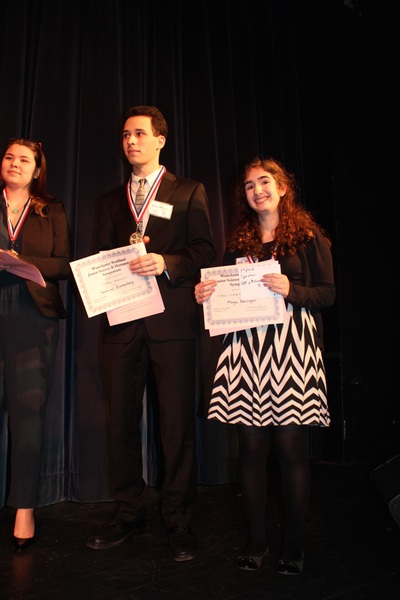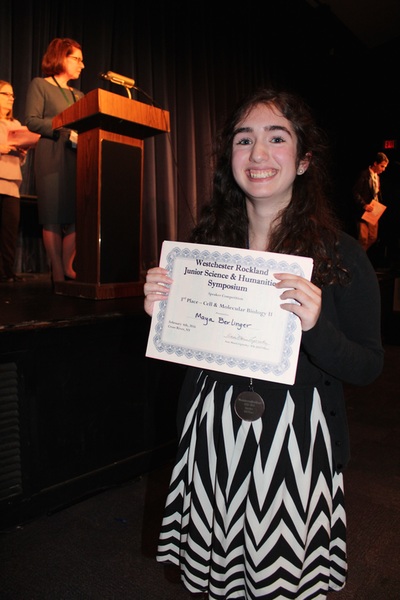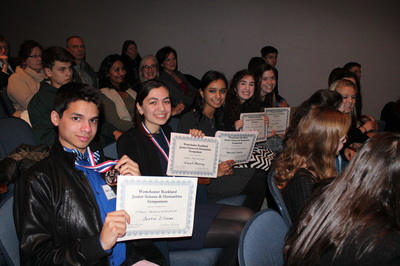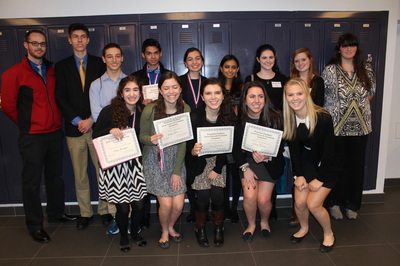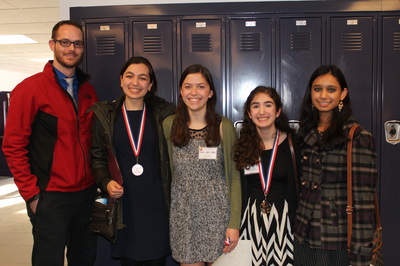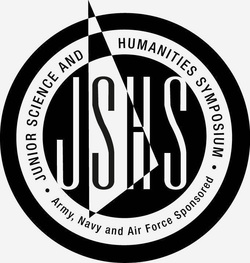
Westchester-Rockland Junior Science & Humanities Symposium (WR-JSHS)
About the Competition:
JSHS is designed to challenge and engage students (Grades 9-12) in science, technology, engineering or mathematics (STEM). Individual students compete for scholarships and recognition by presenting the results of their original research efforts before a panel of judges and an audience of their peers. Opportunities for hands-on workshops, panel discussions, career exploration, research lab visits and networking are planned. By participating in regional and national symposia, students may...
About the Competition:
JSHS is designed to challenge and engage students (Grades 9-12) in science, technology, engineering or mathematics (STEM). Individual students compete for scholarships and recognition by presenting the results of their original research efforts before a panel of judges and an audience of their peers. Opportunities for hands-on workshops, panel discussions, career exploration, research lab visits and networking are planned. By participating in regional and national symposia, students may...
- Participate in a forum honoring individual achievement in STEM
- Qualify for significant scholarships and other recognition
- Network to enrich understanding of STEM pursuits beyond high school;
- Advance in statewide, regional, national and international symposia
- Develop skills to help prepare for undergraduate and graduate pursuits -- skills in the application of science content to solve a problem or to gain new knowledge, writing a paper, and communicating results.
February 5, 2022
Registration Fee: $FREE
Registration Fee: $FREE
Speaker Sessions Students selected as speakers will present their research via PowerPoint presentation virtually over ZOOM. The PowerPoint must NOT include identifying information: NO school name, NO teacher names, and NO mentor/affiliation names.
Speakers must arrive on time for their presentation. If a student is not on time, he or she will not be permitted to present. While room moderators try to keep to the time schedule, it is on occasion not possible. Speakers should remain in the speaker room for the duration of the session (4 speakers per session/3 sessions per room/2 short breaks)
Questions from students will not be permitted during speaker sessions or during a poster judging. During the poster sessions, students may chat with one another and observers may ask questions when a student is not being judged.
Speakers must arrive on time for their presentation. If a student is not on time, he or she will not be permitted to present. While room moderators try to keep to the time schedule, it is on occasion not possible. Speakers should remain in the speaker room for the duration of the session (4 speakers per session/3 sessions per room/2 short breaks)
- Students who place 1st and 2nd in each room will move on to compete as speakers at the Upstate JSHS in Albany.
- Students who place 3rd and 4th will compete in Albany as poster presenters.
Questions from students will not be permitted during speaker sessions or during a poster judging. During the poster sessions, students may chat with one another and observers may ask questions when a student is not being judged.
2019 Virtual Practice Night
2018 Virtual Practice Night
2017 Pictures
2016 Pictures
The National Symposium - Requirements for the Oral Presentations
Session timing.The research presentation may not exceed 12 minutes, followed by a maximum 6-minute question period. A session moderator will aid the student speaker in maintaining this schedule and in fielding questions from the audience. The procedure for maintaining the time includes a 10-minute signal for the student, and finally a 12-minute signal. At the 12-minute point, the student speaker must stop the presentation even if he or she has not finished. Following the presentation, the session moderator will ask for audience questions. The speaker may entertain questions while the exchange appears interesting and relevant. Questions intended to harass the student speakers will not be allowed by the session moderator. The speaker should repeat a question before answering so the audience may understand the entire dialogue.
Use of Audio Visuals - Available equipment. Available audio-visual equipment in each session at National includes: (1) LCD projector; (2) projection screen; and (3) a laser pointer. Additionally, PC-based computers will be in each session room configured with Microsoft Powerpoint and Adobe Acrobat. The use of other software requires students to bring their own equipment. Mac users should plan to bring a Mac adapter to plug-in to available equipment. Equipment operators will not be available in each session. Students should number visuals in sequence so the presenter can easily reshow one. Many times, visuals are re-shown during the questioning period.
Aids to the presentation. No written handouts or models are permitted. Powerpoint and computer action video may be used in the presentation. Please refer to the following section which limits the use of video to a maximum 1- minute time limit. Powerpoint suggestions.
Student presenters are reminded to:
• Embed any video, or other presentation developed through other software, into Powerpoint.
• Save the Powerpoint presentation to an IBM-compatible thumb drive, and plug into available PC-bsed equipment with that thumb drive.
• Bring back-up media.
• If using video, students must comply with the following groundrules…
• The video component cannot make up more than one (1) minute of the presentation and must be directly relevant to the project.
• No audio or background music is permitted other than sounds that are an integral part of the research. Recorded or mechanically produced narration is not permitted. Narration must come from the speaker.
• Videos (and audio, if any) may be used only for those aspects of the presentation that cannot adequately be presented in a slide. Video material presented must be an integral part of the research and should not be a substitute for presentation of data. Videos must not be used for presentation of common procedures, illustrating equipment or showing laboratory facilities. Videos should illustrate work that was done and should not be used for stimulation or aesthetic value. 10 The National Symposium-Suggestions to prepare for the oral presentations
Remember, you are the expert. No one in the audience knows as much about your research investigation as you. Therefore, remember to explain your research in enough detail so the audience will understand what you did, how you did it, and what you learned. Whenever possible, avoid jargon or unnecessary terminology. If it is essential to use specialized terms, remember to explain the specialized term briefly. Give your audience enough time to understand what you are trying to convey.
Graphs, tables and other representation help explain your results. Keep them simple and uncluttered. Focus on important information; for example, remember to name the variables on both axes of a graph, and state the significance of the position and shape of the graph line. Deliver your presentation at a comfortable pace. It helps to practice your presentation before a non-specialized audience. Practice will help perfect the presentation and the timing. Do listen to the advice of your non-specialized audience but also get help from a teacher or other advisors as needed.

